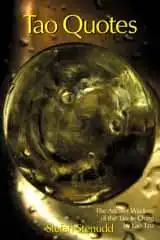|
Tao Te Ching
THE TAOISM OF LAO TZU
|
Tao Te Ching
|
The Book
The Taoism of Lao Tzu Explained. The great Taoist philosophy classic by Lao Tzu translated, and each of the 81 chapters extensively commented. Click the image to see the book at Amazon (paid link). |
The Womb
Lao Tzu allows himself some play with words here. The Chinese word for valley, ku, can be translated gorge, and the word for female (of any species) also refers to a deep gorge. The word for mystical, hsüan, can be translated dark or deep. So, Lao Tzu describes a dark depth, from the entrance of which the whole world springs, like a child does from its mother's womb.
The sign for entrance, also meaning gate or door, shows a swinging door, just like the one to the saloon in every Western movie. In the context of this chapter, it's an image also suggesting the gate to a woman's womb, which is certainly a birthplace of tremendous significance.
To Lao Tzu, the origin of the world is female, like a mother of any species. Heaven and Earth are rooted at the entrance to this womb, but there is a vast depth beneath the entrance, from which so much more can emerge. This mother of all is endlessly fertile. She never ceases to breed and nurture.
This mystical female is Tao, the Way. Again an intriguing imagery. The way to this primordial female leads into the dark gorge.
Tao as a mother of all, like the Greek Earth goddess Gaia, is a returning theme in the Tao Te Ching. Although ancient China was indeed a patriarchal society, Lao Tzu praised the traditionally female qualities repeatedly. Since the nature of Tao resembles the female much more than the male, so should people behave. Giving instead of taking, humble instead of proud, yielding instead of forcing, and so on.
This preference must have been very radical in the days of Lao Tzu. Actually, it still is.
In the last line of this chapter, Lao Tzu leaves the metaphor of the womb, although he still talks about Tao. He moves on to another aspect of it, another way of looking at it. The essence of the Way is as vague and fine as cobweb, because it's a principle, a natural law, with no substance of its own. That's why it lasts, no matter how much it is used. Like a formula.
NEXT
Tao Te Ching Explained
Preface
Introduction
Literature
translated and explained by Stefan Stenudd.
1 |
2 |
3 |
4 |
5 |
6 |
7 |
8 |
9 |
10 |
11 |
12 |
13 |
14 |
15 |
16 |
17 |
18 |
19 |
20 |
21 |
22 |
23 |
24 |
25 |
26 |
27 |
28 |
29 |
30 |
31 |
32 |
33 |
34 |
35 |
36 |
37 |
38 |
39 |
40 |
41 |
42 |
43 |
44 |
45 |
46 |
47 |
48 |
49 |
50 |
51 |
52 |
53 |
54 |
55 |
56 |
57 |
58 |
59 |
60 |
61 |
62 |
63 |
64 |
65 |
66 |
67 |
68 |
69 |
70 |
71 |
72 |
73 |
74 |
75 |
76 |
77 |
78 |
79 |
80 |
81 |
Tao Te Ching Explained
James Legge's Tao Te Ching
Aleister Crowley's Tao Te Ching
The 1st Chapter of Tao Te Ching in 76 Versions
Lao Tzu — Legendary Author of Tao Te Ching
My Taoism BooksClick the image to see the book at Amazon (paid link).
The Taoism of Lao Tzu Explained. The great Taoist philosophy classic by Lao Tzu translated, and each of the 81 chapters extensively commented. |
About Cookies
My Other Websites:
I Ching Online
The 64 hexagrams of the Chinese classic I Ching and what they mean in divination. Try it online for free.
Qi Energy Exercises
The ancient Chinese life energy qi (chi) explained, with simple instructions on how to exercise it.
Life Energy
The many ancient and modern life force beliefs all over the world explained and compared.
Taoismen på svenska
Other Books by Stefan Stenudd
Click the image to see the book at Amazon (paid link).
 Cosmos of the Ancients
Cosmos of the Ancients
The Greek philosophers and what they thought about cosmology, myth, and the gods.
 Qi — Increase Your Life Energy
Qi — Increase Your Life Energy
The life energy qi (also chi or ki) explained, with exercises on how to awaken, increase and use it.
 Aikido Principles
Aikido Principles
Basic concepts of the peaceful martial art. Aikido principles, philosophy, and fundamental ideas.
 Life Energy Encyclopedia
Life Energy Encyclopedia
Qi, prana, spirit, ruach, pneuma, and many other life forces around the world explained and compared.
 Archetypes of Mythology
Archetypes of Mythology
Jungian theories on myth and religion examined, from Carl G. Jung to Jordan B. Peterson.
 Stefan Stenudd
Stefan Stenudd
About me
I'm a Swedish author and aikido instructor. In addition to fiction, I've written books about Taoism and other East Asian traditions. I'm also an historian of ideas, researching ancient thought and mythology. Click the image to get to my personal website.Contact

 Tao Te Ching
Tao Te Ching Tao Quotes
Tao Quotes Fake Lao Tzu Quotes
Fake Lao Tzu Quotes